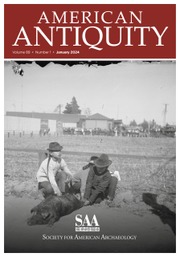No CrossRef data available.
Article contents
The “Twin Stelae” of Seibal
Published online by Cambridge University Press: 20 January 2017
Abstract
At least two sets of stelae at Seibal, Peten, Guatemala are “look-alikes,” and this resemblance may be empirically demonstrated by a series of measurements. The scant variation encountered between measurements of some of the features of the figures on the stelae suggest the use of templates or patterns as a traditional technique among Mayan sculptors during the Classic period.
- Type
- Reports
- Information
- Copyright
- Copyright © The Society for American Archaeology 1977
References
Adams, Richard E. W.
1970
Suggested Classic Period occupational specializations in the southern Maya Lowlands. In Monographs and papers in Maya archaeology, edited by Bullard, William R. Jr., pp. 489–502. Peabody Museum, Harvard University, Papers
61.Google Scholar
Andrews, E. Wyllys, and Ronner, Irwin
1973
Archaeological evidence on social stratification and commerce in the northern Maya Lowlands. Middle American Research Institute, Publications
31:81–102.Google Scholar
Greene, Merle, Rands, Robert L., and Graham, John
1972
Maya sculpture from the southern Lowlands, Highlands and Pacific Piedmont, Guatemala, Mexico, Honduras.
Lederer, Street & Zeus, Berkeley.Google Scholar
Maler, Teobert
1908
Explorations of the upper Usumatsintla and adjacent region. Peabody Museum, Harvard University, Memoirs
4(1).Google Scholar
Miller, Arthur G.
1973
The mural painting of Teotihuacdn.
Dumbarton Oaks, Washington, DC.Google Scholar
Morley, Sylvanus G.
1938
The inscriptions of Peten, Vol. II. Carnegie Institution of Washington, Publication
593.Google Scholar
Proskouriakoff, Tatiana
1950
A study of Classical Maya sculpture. Carnegie Institution of Washington, Publication
493.Google Scholar
Robertson, Merle Greene
1974 Techniques probably used by Palenque sculptors in Mexico. Paper presented at 41 (1974) Congreso Internacional de Americanistas, Mexico D.F.Google Scholar


